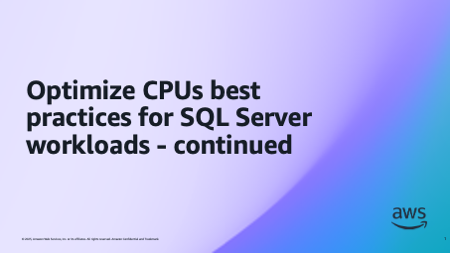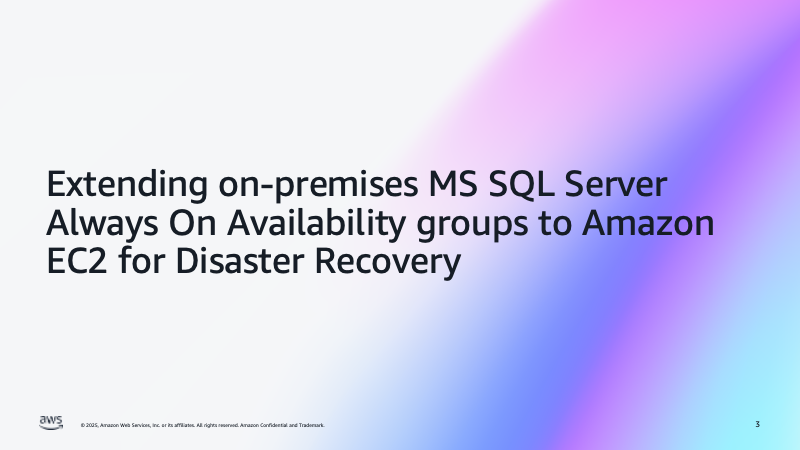Microsoft Workloads on AWS
Category: Learning Levels
Optimize CPUs best practices for SQL Server workloads – continued
In this blog post, we will extend the analysis of the Optimize CPUs feature provided in a previous publication to other Amazon Elastic Compute Cloud (Amazon EC2) instances suitable for deployment of Microsoft SQL Server workloads on the Amazon Web Services (AWS) Cloud. Amazon EC2 now allows customers to modify an instance’s CPU options to […]
Extending on-premises MS SQL Server Always On Availability groups to Amazon EC2 for Disaster Recovery
This post shows how to implement a hybrid disaster recovery solution by extending your on-premises Microsoft SQL Server Always On Availability Group (AOAG) to SQL Server on Amazon Elastic Compute Cloud (Amazon EC2). Introduction Many Organizations need cloud-based disaster recovery solutions that maintain critical on-premises operations while minimizing costs. This post demonstrates how to extend […]
Deploy SQL Server Container Clusters using Amazon EKS and Amazon FSx for Windows
Introduction This blog post shows how to deploy a highly available SQL Server instance in a container using Amazon Elastic Kubernetes Service (Amazon EKS) with persistent storage backed by Amazon FSx for Windows File Server. Running databases and other stateful workloads in containers has grown significantly over the years. According to the CNCF Annual Survey […]
Running SQL Server Stretch Failover Cluster Instance on Amazon EC2
In this blog post, we explore how to implement Microsoft SQL Server Failover Cluster Instance (FCI) on Stretch Cluster Replication in Amazon Elastic Compute Cloud (EC2). We are going to use Amazon Elastic Block Store (EBS) Multi-Attach on io2 volumes with Microsoft Windows Server Storage Replica technology as a shared storage solution across Availability Zones […]
How The Hartford jumpstarted .NET modernization with AWS Transform
This post demonstrates how The Hartford used AWS Transform for .NET to kickstart the modernization of their Skylynx application—achieving 30% automated code transformation within weeks of initial adoption and laying the foundation for broader modernization efforts in the future. Organizations running .NET Framework applications face growing challenges with licensing costs, scalability, innovation, and security. Many […]
Automate SCIM provisioning from Active Directory to IAM Identity Center
In this blog post, we will show you how to build and deploy a custom solution to automate the process of provisioning users and groups from Microsoft Active Directory (AD) to AWS IAM Identity Center using the System for Cross-domain Identity Management (SCIM) protocol. Introduction Many organizations manage their user identities using AD and rely […]
Event-driven Active Directory domain join with Amazon EventBridge
In this blog post, I will show you how Amazon EventBridge can automate Microsoft Active Directory (AD) domain join and unjoin for your Amazon Elastic Compute Cloud (Amazon EC2) instances. In a previous blog post, I showed you how AWS Systems Manager Automation can dynamically domain join and unjoin EC2 instances manually. I have worked […]
MultiCloud cost visibility with Amazon QuickSight and FOCUS
Customers with multi-cloud environments struggle to effectively track and manage their usage and costs. They access the individual billing portals of each cloud provider to gather cost information. Without a consolidated view on cloud expenditure, making data-driven decisions to optimize costs becomes difficult. In September 2023 we introduced the Cloud Intelligence Dashboard for Azure. This […]
Simplifying Active Directory domain join with AWS Systems Manager
In this blog post, I will demonstrate a solution for managing the Active Directory domain membership for a dynamic fleet of Amazon Elastic Compute Cloud (Amazon EC2) Windows instances using AWS Systems Manager Automation. Using Systems Manager Automation, you can dynamically automate domain join and unjoin activities with Microsoft Active Directory (AD) for your Amazon […]
Make SQL Server end of support the start of your AWS cloud journey
Let’s face it. End of support (EOS) –three words that can unsettle any IT professional– is the last thing you want to hear about for your mission-critical applications. It creates additional work for you to deal with the upgrades and causes downtime for your end users. The Microsoft Windows Server and SQL Server end of […]









